Exploration of the Intersectoral Relations Based on Input-Output Tables in the Inland River Basin of China
Abstract
:1. Introduction
2. Materials and Methods
2.1. Study Area
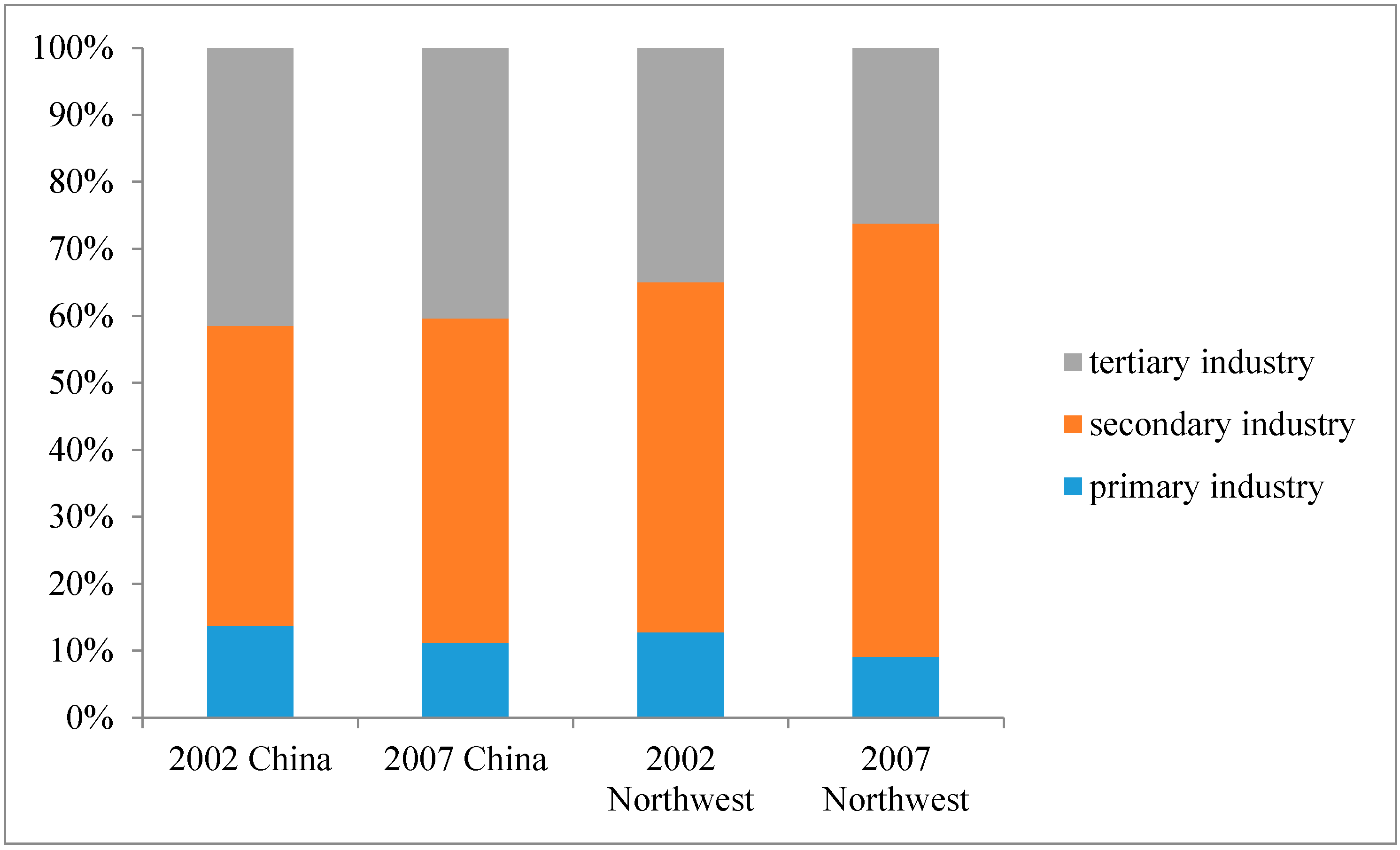

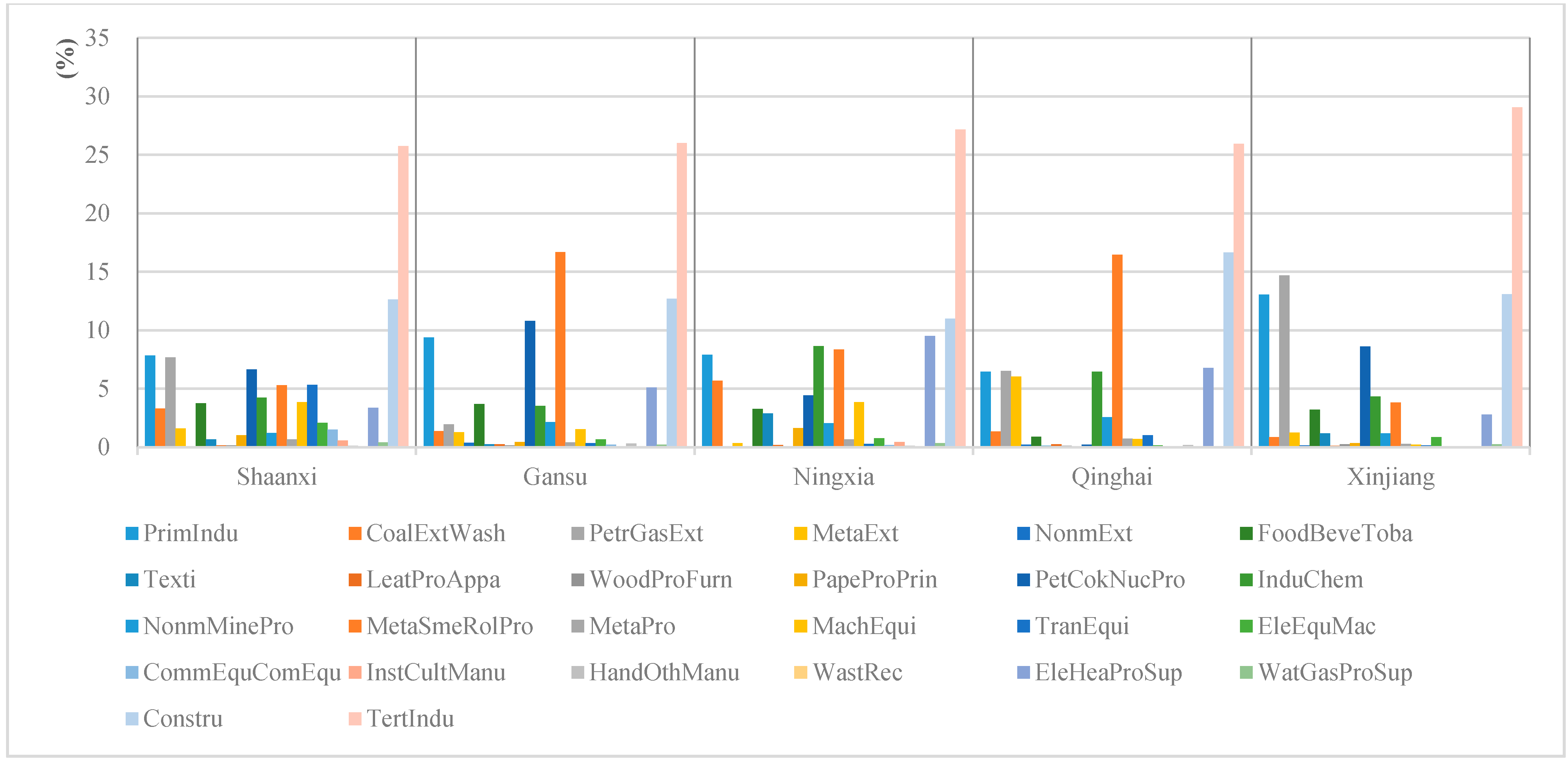
2.2. Data
2.3. I-O Table Analysis
| Intermediate use | Final demand | Gross output | |||||
|---|---|---|---|---|---|---|---|
| 1 | 2 | …… | n | ||||
| Intermediate input | 1 | Xij Quadrant I | Yi Quadrant II | Xi | |||
| 2 | |||||||
| …… | |||||||
| n | |||||||
| Value added | Nj Quadrant III | Quadrant IV | |||||
| gross input | Xj | ||||||
2.4. Inter-Industrial Linkage Analysis
- (1)
- > 1, > 1: This kind of sector is highly radioactive and crucial and has both a pulling and sustaining effect on the national economy. One example might be the construction sector.
- (2)
- > 1, < 1: This kind of sector is highly radioactive and less conditional, which has a high pulling effect and a low sustaining effect. Examples might be the consumer and food sectors.
- (3)
- < 1, > 1: This kind of sector is less radioactive and highly conditional, which has a high sustaining effect and little pulling effect. Those sectors are likely to be in the upstream link in the industrial chain, like electricity, coal, petroleum and steel sectors, etc.
- (4)
- < 1, < 1: This kind of sector is less radioactive and conditional and has both a low sustaining and pulling effect. One example might be the science-education-culture-health sector.
3. Results and Discussion
3.1. The Coefficients of Northwest China
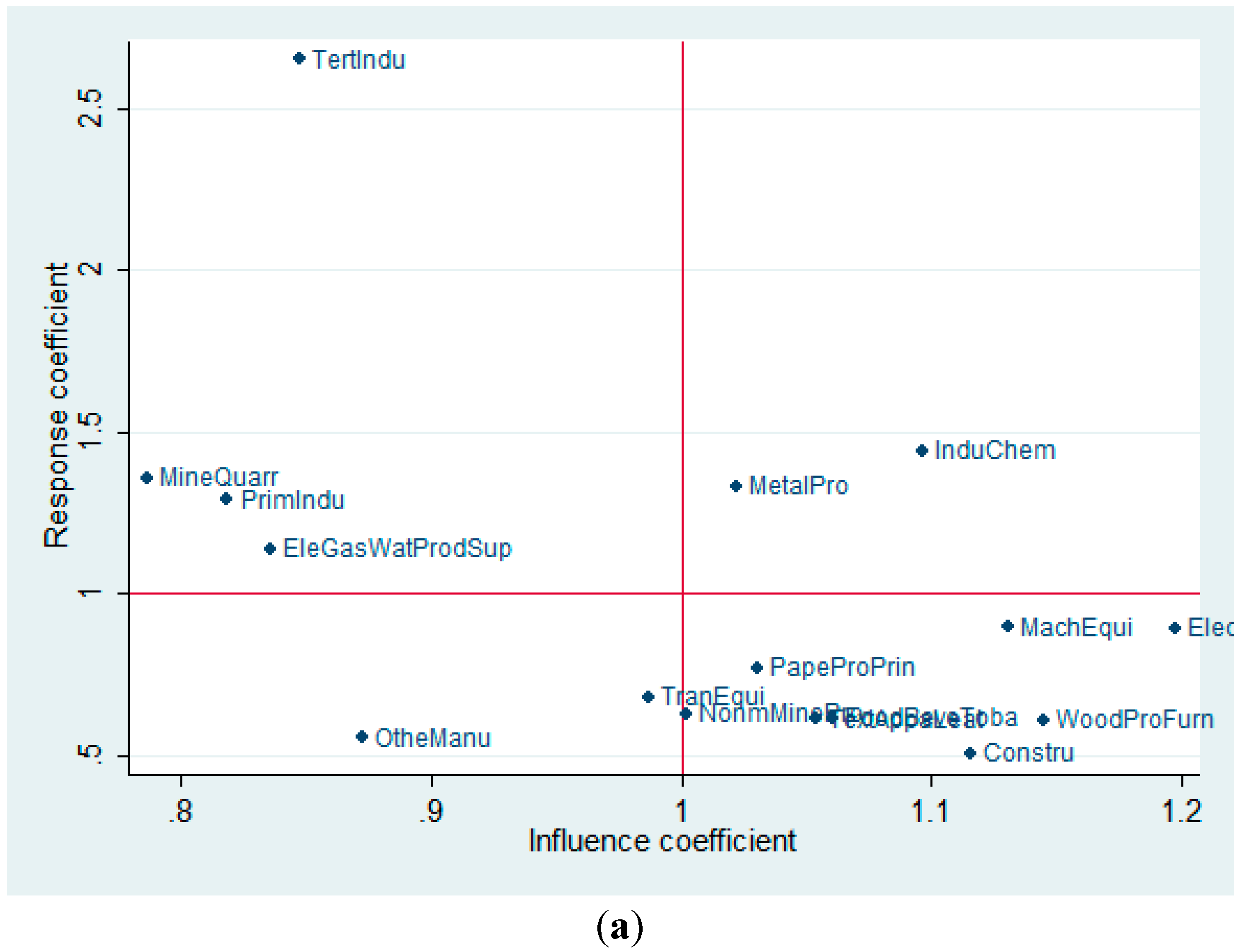
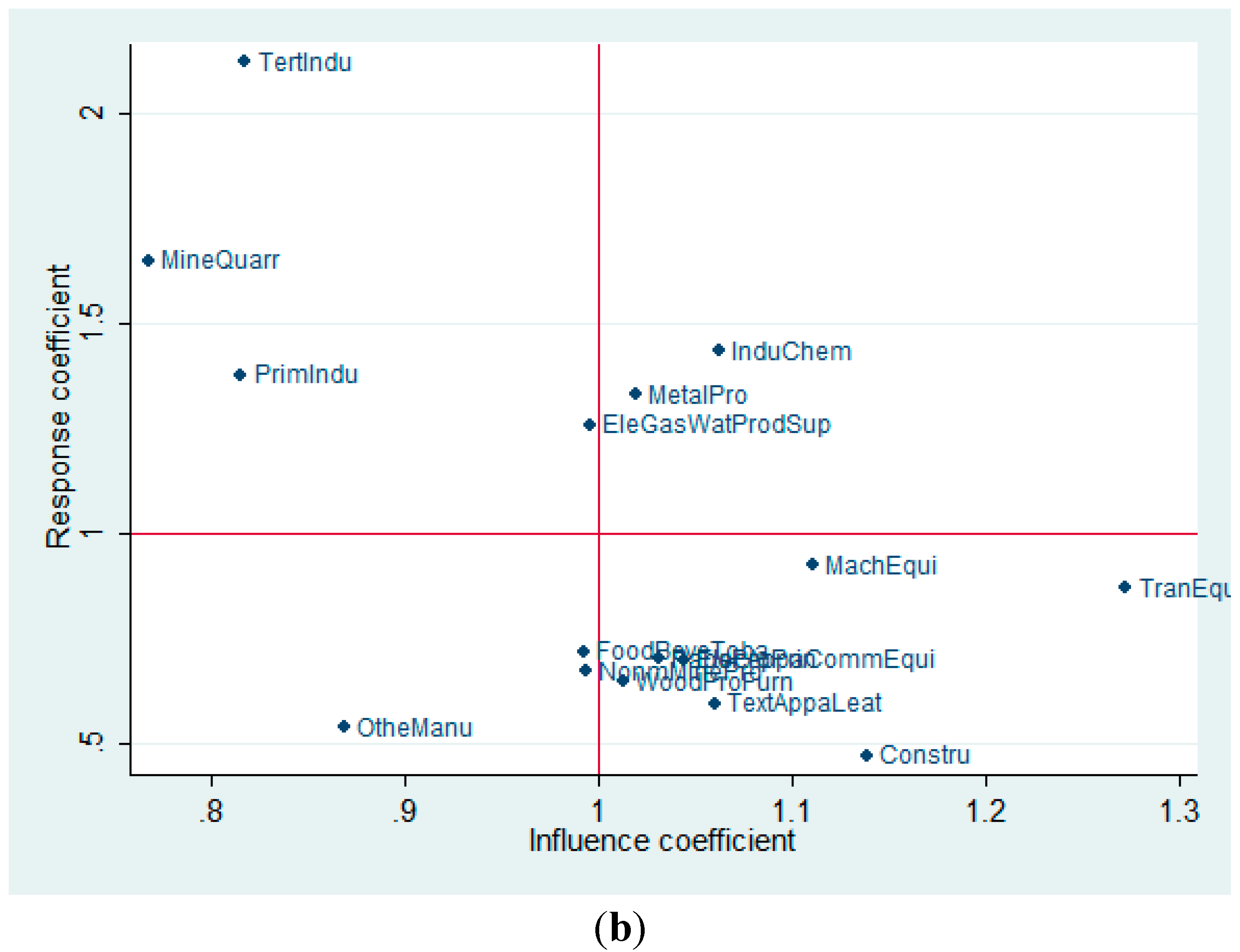
3.2. Estimated Influence and Response Coefficients
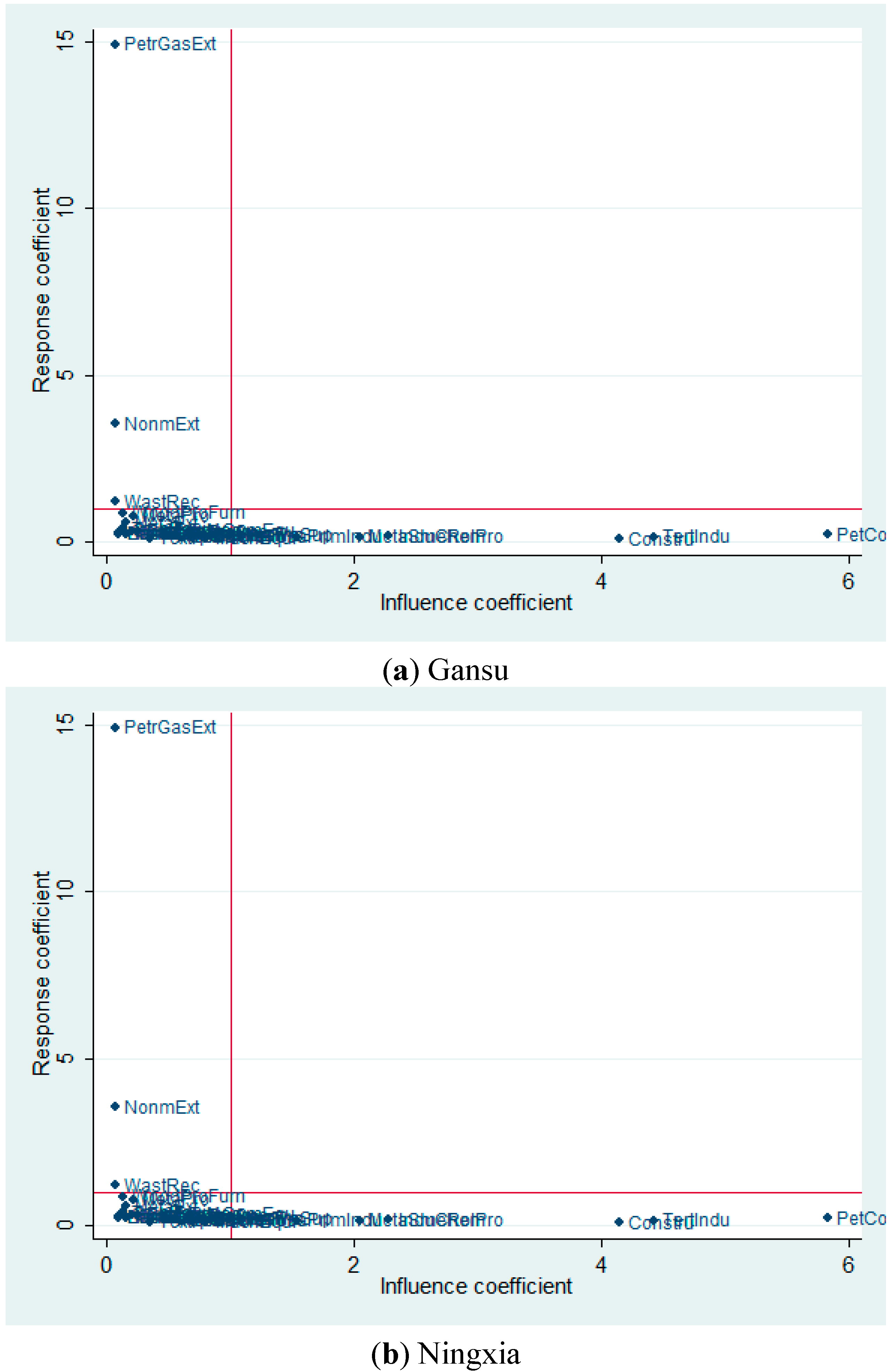
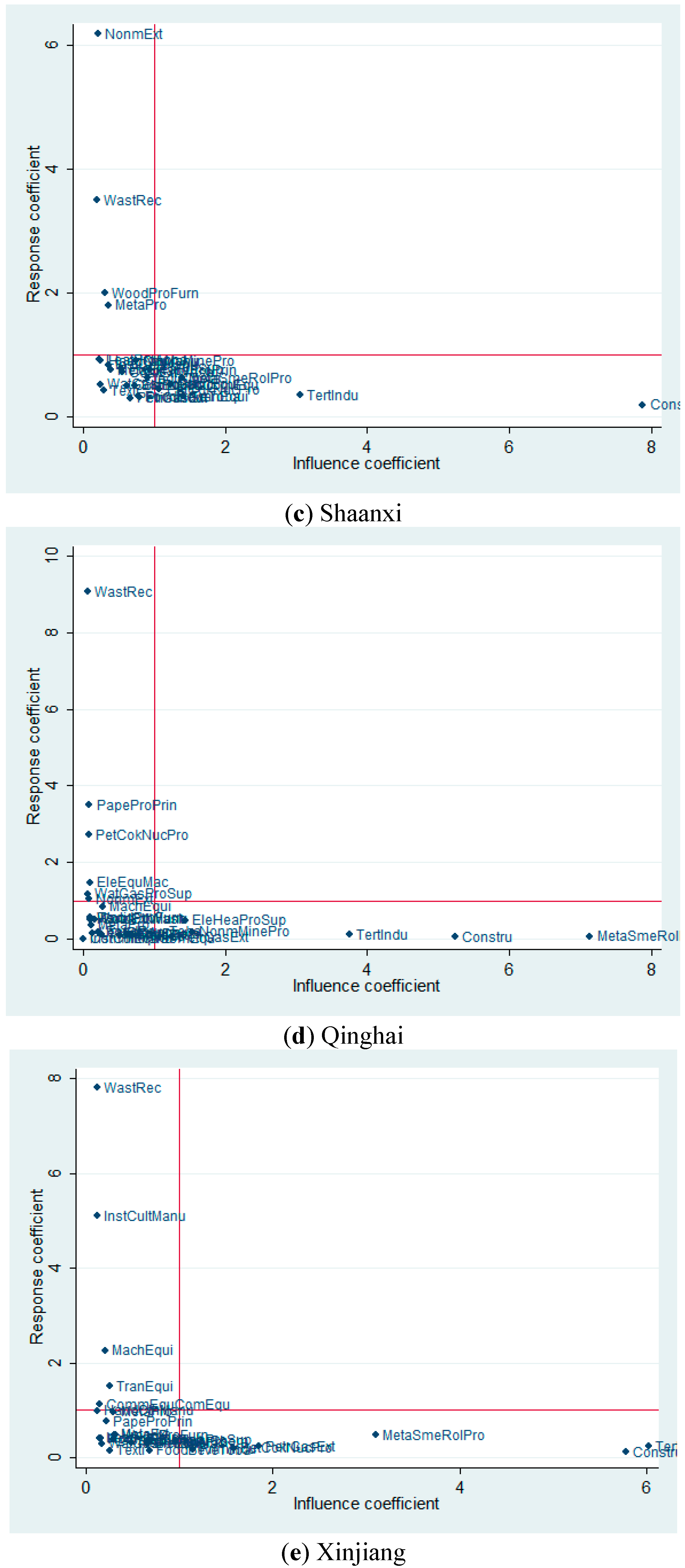
4. Conclusions
Acknowledgments
Author Contributions
Conflicts of Interest
References
- Charmondusit, S.; Bhaktikul, K.; Arunlertaree, C.; Wisawapipat, W.; Rattanapan, C.; Charmondusit, K. Problem Based Training Program on Industrial Ecology and Environment for the Sustainability Management of Industry. Procedia Soc. Behav. Sci. 2012, 40, 31–36. [Google Scholar] [CrossRef]
- Liao, W.; Heijungs, R.; Huppes, G. Thermodynamic analysis of human–environment systems: A review focused on industrial ecology. Ecol. Model. 2012, 228, 76–88. [Google Scholar] [CrossRef]
- Hiller, V. Work organization, preferences dynamics and the industrialization process. Eur. Econ. Rev. 2011, 55, 1007–1025. [Google Scholar] [CrossRef]
- Szirmai, A. Industrialisation as an engine of growth in developing countries, 1950–2005. Struct. Change Econ. Dyn. 2012, 23, 406–420. [Google Scholar] [CrossRef]
- Zhang, H.; Uwasu, M.; Hara, K.; Yabar, H. Sustainable Urban Development and Land Use Change—A Case Study of the Yangtze River Delta in China. Sustainability 2011, 3, 1074–1089. [Google Scholar] [CrossRef]
- Volkery, A.; Swanson, D.; Jacob, K.; Bregha, F.; Pintér, L. Coordination, Challenges, and Innovations in 19 National Sustainable Development Strategies. World Dev. 2006, 34, 2047–2063. [Google Scholar] [CrossRef]
- Ivanovic, O.D.M.; Golusin, M.T.; Dodic, S.N.; Dodic, J.M. Perspectives of sustainable development in countries of Southeastern Europe. Renew. Sustain. Energy Rev. 2009, 13, 2079–2087. [Google Scholar] [CrossRef]
- Esseghir, A.; Haouaoui Khouni, L. Economic growth, energy consumption and sustainable development: The case of the Union for the Mediterranean countries. Energy 2014, 71, 218–225. [Google Scholar] [CrossRef]
- Diao, X.D.; Zeng, S.X.; Tam, C.M.; Tam, V.W.Y. EKC analysis for studying economic growth and environmental quality: A case study in China. J. Clean. Prod. 2009, 17, 541–548. [Google Scholar] [CrossRef]
- Baojuan, S.; Rongrong, Z.; Ying, Z. Empirical Analysis of Tangshan Economic Growth and Environmental Pollution. Energy Procedia 2011, 5, 2392–2396. [Google Scholar] [CrossRef]
- Dong, Y.; Ishikawa, M.; Liu, X.; Hamori, S. The determinants of citizen complaints on environmental pollution: An empirical study from China. J. Clean. Prod. 2011, 19, 1306–1314. [Google Scholar] [CrossRef]
- Hu, H.; Zhang, X.-H.; Lin, L.-L. The interactions between China’s economic growth, energy production and consumption and the related air emissions during 2000–2011. Ecol. Indic. 2014, 46, 38–51. [Google Scholar] [CrossRef]
- Dong, X.; Song, S.; Zhu, H. Industrial structure and economic fluctuation—Evidence from China. Soc. Sci. J. 2011, 48, 468–477. [Google Scholar] [CrossRef]
- He, J.; Wang, H. Economic structure, development policy and environmental quality: An empirical analysis of environmental Kuznets curves with Chinese municipal data. Ecol. Econ. 2012, 76, 49–59. [Google Scholar] [CrossRef]
- Yang, S.; Bai, Y.; Wang, S.; Feng, N. Evaluating the transformation of China’s industrial development mode during 2000–2009. Renew. Sustain. Energy Rev. 2013, 20, 585–594. [Google Scholar] [CrossRef]
- Wen, Z.; Chen, J. A cost-benefit analysis for the economic growth in China. Ecol. Econ. 2008, 65, 356–366. [Google Scholar] [CrossRef]
- Chen, X. Modes of state intervention and business group performance in China’s transitional economy. J. Socio Econ. 2010, 39, 619–630. [Google Scholar] [CrossRef]
- Wang, F.; Dong, B.; Yin, X.; An, C. China’s structural change: A new SDA model. Econ. Model. 2014, 43, 256–266. [Google Scholar] [CrossRef]
- Roberts, B.H. The application of industrial ecology principles and planning guidelines for the development of eco-industrial parks: An Australian case study. J. Clean. Prod. 2004, 12, 997–1010. [Google Scholar] [CrossRef]
- Elabras Veiga, L.B.; Magrini, A. Eco-industrial park development in Rio de Janeiro, Brazil: A tool for sustainable development. J. Clean. Prod. 2009, 17, 653–661. [Google Scholar] [CrossRef]
- Abou-Ali, H.; Abdelfattah, Y.M. Integrated paradigm for sustainable development: A panel data study. Econ. Model. 2013, 30, 334–342. [Google Scholar] [CrossRef]
- Burns, A.F. Prodiction Trands in the United States Since 1870; National Bureau of Economic Research: New York, NY, USA, 1934. [Google Scholar]
- Kuznets, P.W. Asian industrialization: Is there a paradigm? J. Asian Econ. 1994, 5, 491–497. [Google Scholar] [CrossRef]
- Mackenzie, C.L.; Bell, M.C.; Birchenough, S.N.R.; Culloty, S.C.; Sanderson, W.G.; Whiteley, N.M.; Malham, S.K. Future socio-economic and environmental sustainability of the Irish Sea requires a multi-disciplinary approach with industry and research collaboration, and cross-border partnership. Ocean Coast. Manag. 2013, 85, 1–6. [Google Scholar] [CrossRef]
- Deng, X.; Zhang, F.; Wang, Z.; Li, X.; Zhang, T. An Extended Input Output Table Compiled for Analyzing Water Demand and Consumption at County Level in China. Sustainability 2014, 6, 3301–3320. [Google Scholar] [CrossRef]
- Wiek, A.; Lang, D.J.; Siegrist, M. Qualitative system analysis as a means for sustainable governance of emerging technologies: The case of nanotechnology. J. Clean. Prod. 2008, 16, 988–999. [Google Scholar] [CrossRef]
- Wang, B.-J.; Zhou, M.; Ji, F. Analyzing on the selecting behavior of mining cities’ industrial transition based on the viewpoint of sustainable development: A perspective of evolutionary game. Procedia Earth Planet. Sci. 2009, 1, 1647–1653. [Google Scholar] [CrossRef]
- Wangel, J. Exploring social structures and agency in backcasting studies for sustainable development. Technol. Forecast. Soc. Change 2011, 78, 872–882. [Google Scholar] [CrossRef]
- Cerceau, J.; Mat, N.; Junqua, G.; Lin, L.; Laforest, V.; Gonzalez, C. Implementing industrial ecology in port cities: International overview of case studies and cross-case analysis. J. Clean. Prod. 2014, 74, 1–16. [Google Scholar] [CrossRef]
- Artmann, M. Institutional efficiency of urban soil sealing management–From raising awareness to better implementation of sustainable development in Germany. Landsc. Urb. Plan. 2014, 131, 83–95. [Google Scholar] [CrossRef]
- He, Z.; Rayman-Bacchus, L.; Wu, Y. Self-organization of industrial clustering in a transition economy: A proposed framework and case study evidence from China. Res. Policy 2011, 40, 1280–1294. [Google Scholar] [CrossRef]
- Cheng, G.; Li, X.; Zhao, W.; Xu, Z.; Feng, Q.; Xiao, S.; Xiao, H. Integrated study of the water–ecosystem–economy in the Heihe River Basin. Natl. Sci. Rev. 2014, 1, 413–428. [Google Scholar] [CrossRef]
- Zhang, Y.; Qi, S. Regional Input-Output Tables of China; China Statistical Press: Beijing, China, 2012. [Google Scholar]
- Input-Output Tables of China; State Statistical Bureau of China: Beijing, China, 2007.
© 2015 by the authors; licensee MDPI, Basel, Switzerland. This article is an open access article distributed under the terms and conditions of the Creative Commons Attribution license (http://creativecommons.org/licenses/by/4.0/).
Share and Cite
Shi, Q.; Deng, X.; Shi, C.; Chen, S. Exploration of the Intersectoral Relations Based on Input-Output Tables in the Inland River Basin of China. Sustainability 2015, 7, 4323-4340. https://doi.org/10.3390/su7044323
Shi Q, Deng X, Shi C, Chen S. Exploration of the Intersectoral Relations Based on Input-Output Tables in the Inland River Basin of China. Sustainability. 2015; 7(4):4323-4340. https://doi.org/10.3390/su7044323
Chicago/Turabian StyleShi, Qingling, Xiangzheng Deng, Chenchen Shi, and Shiyi Chen. 2015. "Exploration of the Intersectoral Relations Based on Input-Output Tables in the Inland River Basin of China" Sustainability 7, no. 4: 4323-4340. https://doi.org/10.3390/su7044323
APA StyleShi, Q., Deng, X., Shi, C., & Chen, S. (2015). Exploration of the Intersectoral Relations Based on Input-Output Tables in the Inland River Basin of China. Sustainability, 7(4), 4323-4340. https://doi.org/10.3390/su7044323







